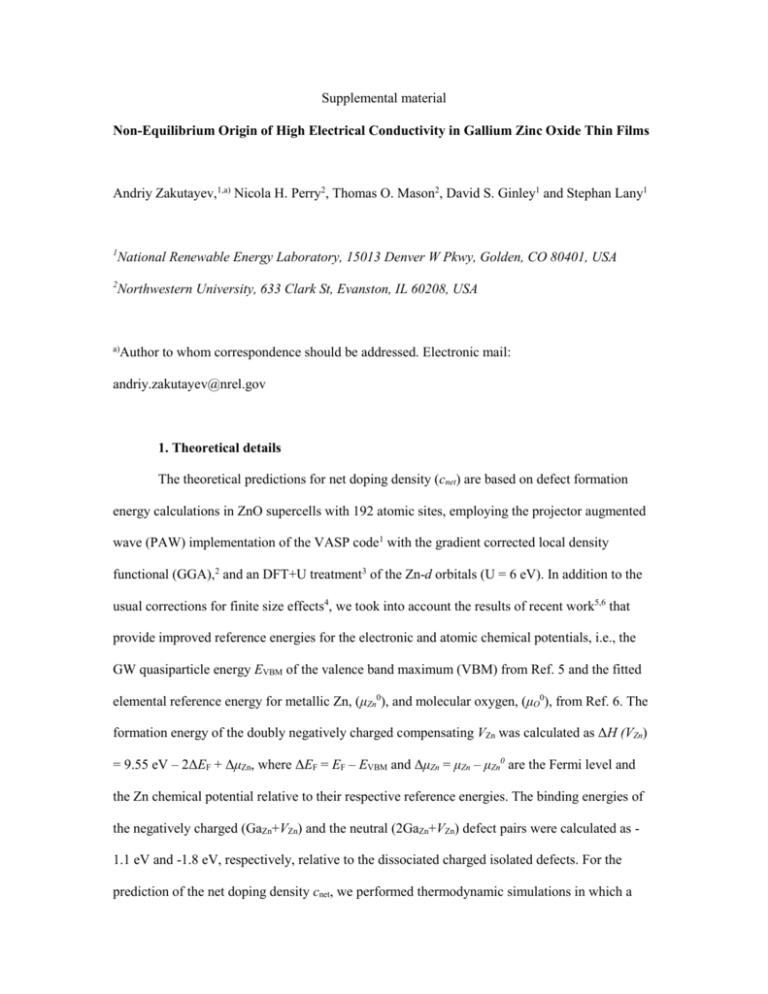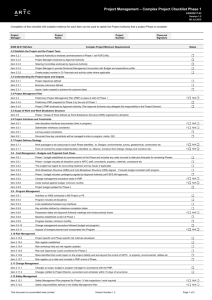nonequilibrium_supplemental_material_APL
advertisement

Supplemental material Non-Equilibrium Origin of High Electrical Conductivity in Gallium Zinc Oxide Thin Films Andriy Zakutayev,1,a) Nicola H. Perry2, Thomas O. Mason2, David S. Ginley1 and Stephan Lany1 1 National Renewable Energy Laboratory, 15013 Denver W Pkwy, Golden, CO 80401, USA 2 Northwestern University, 633 Clark St, Evanston, IL 60208, USA a) Author to whom correspondence should be addressed. Electronic mail: andriy.zakutayev@nrel.gov 1. Theoretical details The theoretical predictions for net doping density (cnet) are based on defect formation energy calculations in ZnO supercells with 192 atomic sites, employing the projector augmented wave (PAW) implementation of the VASP code1 with the gradient corrected local density functional (GGA),2 and an DFT+U treatment3 of the Zn-d orbitals (U = 6 eV). In addition to the usual corrections for finite size effects4, we took into account the results of recent work5,6 that provide improved reference energies for the electronic and atomic chemical potentials, i.e., the GW quasiparticle energy EVBM of the valence band maximum (VBM) from Ref. 5 and the fitted elemental reference energy for metallic Zn, (μZn0), and molecular oxygen, (μO0), from Ref. 6. The formation energy of the doubly negatively charged compensating VZn was calculated as ΔH (VZn) = 9.55 eV – 2ΔEF + ΔμZn, where ΔEF = EF – EVBM and ΔμZn = μZn – μZn0 are the Fermi level and the Zn chemical potential relative to their respective reference energies. The binding energies of the negatively charged (GaZn+VZn) and the neutral (2GaZn+VZn) defect pairs were calculated as 1.1 eV and -1.8 eV, respectively, relative to the dissociated charged isolated defects. For the prediction of the net doping density cnet, we performed thermodynamic simulations in which a self-consistent solution for the Fermi level, the defect concentrations, and the carrier (electron and hole) densities were determined numerically from the condition of an overall charge balance. As in our previous work,7 we include the temperature dependence of the band gap.8 In addition, here we included the effect of defect pair association according to the law of mass action.9 A comparison of the present results with those published earlier7, discussing the effects of the improved reference energies and the defect pair formation, is provided below. 2. Comparison of the theoretical results with previous work Compared to the previous work7, here we take into account for theoretical calculations the improved reference energies for the electronic and atomic chemical potential: (a) the energy EVBM of the valence band maximum, determined from GW quasiparticle energy calculations,5 and (b) the elemental phase energies μZn0 and μO0, determined by fitting to the calculated compound total-energies and experimental compound formation enthalpies ΔHf.6 We also now take into account in the thermodynamic modeling the effect of defect pair association.9 In Fig. S1, these effects are individually quantified. The net doping density cnet is strongly increased when the improved reference energies are included, which is mainly a result of the GW quasiparticle energy shift ΔEVBM = -1.0 eV5 that increases the formation energy of the doubly charged VZn defect ΔHD(VZn) by 2.0 eV. On the other hand, the binding energies9 of -1.1 and -1.8 eV of the (GaZn-VZn) and (2GaZn-VZn) defect pairs effectively lower ΔHD(VZn) thereby decreasing cnet. The combined effect is a moderate increase of the net doping relative to the results of the previous work7 particularly under oxidizing conditions. FIG S1. The net doping density cnet as a function of pO2 at 800 C, determined as in previous work,7 but now including the improved reference energies (Eref)5,6 and the effect of defect-pair association.9 3. Experimental details The experimental studies of conductivity (ex situ) as function of T and pO2 during the growth (Fig. 2, blue symbols) were performed using a thin film combinatorial approach.10,11,12 The gallium zinc oxide thin film sample libraries with 200-400 nm thickness were fabricated by pulsed laser deposition (PLD) using KrF excimer laser from 8 at.% Ga doped ZnO target on stationary Eagle XG amorphous glass substrates with 320 - 600 C temperature difference across 50 mm. The total pressure (O2 and Ar) was fixed to Ptot = 2x10-6 atm for the libraries deposited at pO2= 10-8 -10-6 atm, and Ptot = 2x10-4 atm for the libraries deposited at pO2 = 10-5 -10-4 atm. The libraries were mapped for cation composition and thickness using x-ray fluorescence (XRF), for crystallographic structure using x-ray diffraction (XRD) and for sheet resistance using collinear 4-point probe technique. Room-temperature ex-situ Hall effect measurements were performed on the similar samples as described above, except co-deposited from undoped and 4% Ga doped ZnO targets on rotating 10 x 10 mm fused silica (a-SiO2) and 0001-oriented sapphire (Al2O3) substrates held at 250C in pO2= 10-8 and Ptot = 2x10-6 atm. After the depositions, these samples were equilibrated for >12 hours at T = 250 - 450 C in pO2 = 10-8 atm, and at T = 450 C in pO2 cycled between 10-8 atm and 10-4 atm, and then cooled down to room temperature as fast as possible (~1oC/sec for the first 3 minutes). Hall effect measurements were performed in the Van der Pauw configuration in addition to all other characterization described above. Electrical properties of the Ga doped ZnO thin films were measured in situ (Fig. 2, red symbols) as a function of temperature (T) and oxygen partial pressure (pO2).13 For these measurements, we used the highly conductive gallium zinc oxide samples (σ = 3000 S/cm, n = 8 x 1020 cm-3) that were deposited as described above. The samples were measured in a tube furnace under flowing mixtures of Ar and O2 gases, with a zirconia sensor measuring pO2 and Stype thermocouples serving as electrical contacts in van der Pauw configuration. Measured ohmic voltages were corrected for thermal gradient-induced EMF using current reversal, and measurements were repeated at 90° rotation for each condition to correct for any asymmetry in contact position. During the in-situ measurements, the T was varied in the 300 - 800 C range for pO2 = 1 atm, and the pO2 was cycled in the 1 - 10-4 atm range for T = 600 C. For all the measurements performed above 400 C, the conductivity was ensured to reach the equilibrium state before the measurement was taken. 4. Results and discussion of combinatorial experiments The results of the combinatorial experiments (Fig. 1b) indicate that, depending on the pO2 and Ts during the synthesis, in terms of chemical composition and electrical conductivity there are three distinct regions of Ga-doped ZnO thin film properties: (1) Region-1 (green in Fig. 1b). In the low-temperature/low-pressure regime (Ts < 450C and pO2 < 10-6 atm, Ptot = 2x10-6 atm, green region in Fig. 1a), the conductivity is >100 S/cm and the films are 00L-oriented with 4% larger c-axis lattice constant compared to the bulk equilibrium value caused by high ~20 at. % Ga concentration, which indicates a substantial loss of Zn during the deposition from the 8% target. (2) Region-2 (red region in Fig. 1b). Increase in temperature (Ts > 450C) at all pressures (red region in Fig. 1b) leads to further Zn loss, and eventually formation of an insulating ZnGa2O4 phase and desorption of the film around 600 C. (3) Region-3 (blue region in Fig. 1b). Increase in pressure at low temperature (pO2 > 10-5 atm, Ptot = 2x10-4 atm, Ts < 500 C, blue region in Fig. 1b), suppresses the loss of Zn and results in the growth of polycrystalline semi-insulating (0.1 - 10 S/cm) thin films with 8 at. % Ga and nearly equilibrium c-axis lattice constant. Qualitative explanation of the pO2 - T trends of the composition and the conductivity in gallium zinc oxide thin films described above is as follows: (a) Composition. In thermodynamic equilibrium, the formation of ZnO is described by the relation ΔμO + ΔμZn = ΔHfZnO. Therefore, as ΔμO decreases with decreasing pO2 and increasing Ts,23 ΔμZn has to increase (i.e. Zn has to evaporate) in order to maintain the constant ΔHfZnO in equilibrium. This explains why during the thin film growth increase of ΔμZn with increasing temperature (Ts > 450C) leads to the loss of Zn from a film (region-2, red in Fig. 1b), and decrease of ΔμZn with increasing pO2 (pO2 > 10-5 atm, Ptot = 2x10-4 atm) leads to suppression of Zn loss (region-3, blue in Fig. 1b). (b) Conductivity. The decrease of conductivity in Ga:ZnO with increasing pO2 (region-3, blue in Fig. 1b) can be explained by the compensation of the GaZn donors by doubly-charged VZn acceptors, which is written as ZnZnX+ OOX + 2e' → VZn'' + 1/2O2(g) in the Kröger-Vink notation.11 From the defect reaction above, assuming thermodynamic equilibrium and using the law of mass action, it follows that n(pO2) = K-1/2 c(VZn)-1/2 pO2-1/4, where K is the reaction constant that describes this region of the Brouwer diagram. This equation indicates that in equilibrium the expected power law exponent of the n(pO2) dependence should be -1/4, in contrast to the measured ~-1/2 power law exponent of the σ(pO2) dependence at <450C (Fig. 1b and Fig. 2b). The discrepancy between the expected and the measured power law exponents of conductivity can be attributed to non-equilibrium effects that can be described using the following kinetic considerations. For the deposition process where the growing thin film equilibrates through interaction with O2 molecules in the gas phase, the equilibration rate Req can be written as Req = (c pO2 T-1/2) exp[-Ekin/kBT], where Ekin is energy barrier for equilibration, and c is a constant that does not depend on pO2 and T. Here, (c pO2 T-1/2) describes the rate of the filmgas equilibration events (successful and unsuccessful) in the ideal gas law approximation, and exp[-Ekin/kBT] describes the temperature-dependent fraction of successful film-gas equilibration events. According to this equation, equilibration rate of a growing thin film with a surrounding gas phase increases slowly with pO2 and quickly T, which is physically intuitive and consistent with the trends observed in Fig. 1b. In addition, according to both in-situ and ex-situ experiments (Fig. 2), the observed equilibration times decreased considerably with increasing T and pO2, supporting the gas phase equilibration model described above. References 1 G. Kresse, D. Joubert, Phys. Rev. B 1999, 59, 1758. 2 J. P. Perdew, K. Burke, M. Ernzerhof, Phys. Rev. Lett. 1996, 77, 3865. 3 S. L. Dudarev, G. A. Botton, S. Y. Savrasov, C. J. Humphreys, A. P. Sutton, Phys. Rev. B 1998, 57, 1505. 4 S. Lany, and A. Zunger, Phys. Rev. B 78, 235104 (2008) 5 L. Y. Lim, S. Lany, Y. J. Chang, E. Rotenberg, A. Zunger, and M. F. Toney, Phys. Rev. B 86, 235113 (2012) 6 S. Lany, Phys. Rev. B 78, 245207 (2008) 7 S. Lany and A. Zunger Phys. Rev. Lett. 98, 045501 (2007) 8 F. J. Manjón, M. Mollar, M.A. Hernández-Fenollosa, B. Marı,́ R. Lauck, and M. Cardona, Solid State Comm. 128, 35 (2003) 9 K. Biswas, and S. Lany, Phys. Rev. B 80, 115206 (2009) 10 A. Zakutayev, F. J. Luciano, V. P. Bollinger, A. K. Sigdel, P. F. Ndione, J. D. Perkins, J. J. Berry, P. A. Parilla, and D. S. Ginley, Rev. Sci. Instr. 84, 053905 (2013) 11 A. Zakutayev, T. R. Paudel, P. F. Ndione, J. D. Perkins, S. Lany, A. Zunger and D. S. Ginley, Phys. Rev. B 85, 085204 (2012) 12 A. Zakutayev, J. D. Perkins, P. A. Parilla, N. E. Widjonarko, A. K. Sigdel, J. J. Berry and D. S. Ginley, MRS Communications 1, 23 (2011) 13 G. B. González, T. O. Mason, J. P. Quintana, O. Warschkow, D. E. Ellis, J.-H. Hwang, J. P. Hodges, and J. D. Jorgensen, Journ. Appl. Phys. 96, 3912 (2004)







